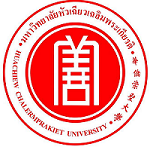Please use this identifier to cite or link to this item:
https://has.hcu.ac.th/jspui/handle/123456789/944Full metadata record
| DC Field | Value | Language |
|---|---|---|
| dc.contributor.advisor | 熊柱 | - |
| dc.contributor.advisor | Xiong, Zhu | - |
| dc.contributor.author | 邓莹 | - |
| dc.contributor.author | Deng, Ying | - |
| dc.contributor.other | Huachiew Chalermprakiet University. College of Chinese Studies | - |
| dc.date.accessioned | 2022-11-06T08:57:18Z | - |
| dc.date.available | 2022-11-06T08:57:18Z | - |
| dc.date.issued | 2019 | - |
| dc.identifier.uri | https://has.hcu.ac.th/jspui/handle/123456789/944 | - |
| dc.description | Thesis (M.A.) (Teaching Chinese) -- Huachiew Chalermprakiet University, 2019 | th |
| dc.description.abstract | ด้วยการพัฒนาอย่างต่อเนื่องของความแข็งแกร่งของประเทศที่ครอบคลุมของจีน "ไข้จีน" ทั่วทุกมุมโลก ประเทศไทยและจีนมีการติดต่อใกล้ชิดกันมาตั้งแต่สมัยโบราณ ในช่วงไม่กี่ปีที่ผ่านมาการแลกเปลี่ยนทางวัฒนธรรมและเศรษฐกิจมีมากขึ้นเรื่อยๆ ดังนั้น ภาษาจีนจึงกลายเป็นหนึ่งในภาษาต่างประเทศที่คนไทยหลายคนต้องเรียนรู้ นอกจากนี้ "ครูสอนภาษาจีน" ของสถาบันขงจื้อที่ดำเนินการโดยสถาบันภาษาจีนได้กลายเป็นสิ่งสำคัญสำหรับคนไทย โครงการให้การสนับสนุนการสอนภาษาจีนในประเทศไทย หลักสูตรภาษาจีนเปิดสอนในโรงเรียนของรัฐและเอกชนทั่วประเทศรวมถึงโรงเรียนอนุบาล กลุ่มการเรียนรู้พิเศษเป็นกลุ่มที่เหมาะกับเด็กเตรียมอนุบาล พวกเขามีลักษณะการรับรู้เฉพาะของตัวเอง ลักษณะทางจิตวิทยาและลักษณะการเรียนรู้ การสอนคำศัพท์ได้กลายเป็นส่วนสำคัญของการสอนภาษาจีนสำหรับเด็กเตรียมอนุบาล จากการศึกษาและประเมินผลการเรียนการสอนคำศัพท์ภาษาจีนในโรงเรียนอนุบาลและผ่านการวิเคราะห์เปรียบเทียบ ผู้เขียนศึกษาและอภิปรายเกี่ยวกับคำศัพท์ภาษาจีนสำหรับเด็กไทยเป็นภาษาที่สอง และหวังว่าจะให้ข้อมูลอ้างอิงสำหรับการสอนคำศัพท์ภาษาจีนสำหรับคนไทย บทความนี้แบ่งออกเป็น 6 ส่วน บทแรก คือ ส่วนแนะนำ โดยเน้นที่มาและความสำคัญของการศึกษาภาพรวมของสถานการณ์การวิจัยในปัจจุบัน พื้นฐานทางทฤษฎีของการศึกษาภาษาจีนของเด็กไทย เช่นเดียวกับวัตถุประสงค์ของการศึกษาและวิธีการวิจัยหลัก เด็กไทยมักจะขาดความรู้ความเข้าใจในลำดับและสถานการณ์ของการเรียนรู้คำศัพท์ บทที่สอง บทความนี้ได้วิจัยเกี่ยวกับสถานการณ์การเรียนการสอนของโรงเรียนอนุบาลมาเรีย ลักษณะของการเรียนและเนื้อหาของการสอนภาษาจีนในโรงเรียน บทที่สาม ศูนย์การสอนของมาเรียนในกรุงเทพฯ ผ่านการเปรียบเทียบการสอนและการสอบภาคปลาย การวิเคราะห์คำศัพท์ภาษาจีนของเด็กไทย บทที่สี่ วิเคราะห์ลำดับและเหตุผลของคำนาม คำกิริยา และคำคุณศัพท์ที่ได้มาจากเด็กไทย บนพื้นฐานของการพูดคุยเกี่ยวกับวิธีการปรับปรุงการเรียนการสอนคำศัพท์ภาษาจีนของเด็กไทย ในส่วนนี้จะสรุปประสบการณ์และการตรัสรู้เกี่ยวกับการปรับปรุงการเรียนการสอนคำศัพท์ภาษาจีนของเด็ก เพื่อให้บริการเรียนการสอนคำศัพท์ภาษาจีน บทที่ห้า พูดถึงวิธีการพัฒนาการเรียนการสอนคำศัพท์ภาษาจีนในวัยเด็กในประเทศไทย ส่วนที่หก คือ ส่วนสรุปของวิจัย | th |
| dc.description.abstract | With the continuoud enhancement of China's comprehensive national strength, a "Chinese fever" has arisen all over the world. Thailand and China have been in close contact with each other since ancient times. In recent years, cultural and economic exchanges have become more and more frequent. Therefore, Chinese has become one of the foreign languages that many Thais must learn. In addition, the "Chinese Teacher Volunteer" of the Confucius Institute run by the Chinese Languae Institute has become a must for many Thais. The project provides strong support for Chinese language teaching in Thailand. Chinese language courses are offered in public and privaye schools throughout the country, including kindergartens. Preschool children are special learning groups. They have their own unique cognitive characteristics, psychologiccal characteristics and learning characteristics. Vocabulary teaching has become an important part of Chinese teaching for preschool children due to the uniqueness of preschool children in all aspects. Based on the practice and assessment of Chinese vocabulary teaching in kindergartens and through comparative analysis, the author studies and discusses the acquisition sequence of Thai children's Chinese vocabulary as a second language, hoping to supplement the research in relateed field and provide some net information for Thai children's Chinese vocabulary teaching in classroom. Residual reference. This paper is divided into six parts. The first chapter is the introduction part, focusing on the origin and significance of the study, the overview of the current research situation, the theoretical basis of children's acquisition of Chinese, as well as the object of this study and the main research methods. Thai children's Chinese language teaching has always been a lack of understanding of the sequence and situation of Thai children's acquisition of vocabulary, lack of understanding of the characteristics of children's Chinese acquisition and the study of Chinese vocabulary classroom teaching. The second chapter introduces the research object of this paper: the situation of Maria coming to school in Bangkok, the situation of Chinese teaching in kindergartens, the characteristics of Chinese learning in Maria coming to school in Bangkok and the content of Chinese teaching in schools. Chapter three centers on the teaching practice of Maria in Bangkok. Through the comparison of teaching practice and the final examination, the sequence of Chinese vocabulary acquisition of Thai children is analyzed. Chapter Foure explores the sequences of Thai children's acquisiotion of Thai children as as second language vocaabulary and the reasons for its formation four aspects. On the basis of discussing the sequence of Chinese vocabulary acquisition of Thai children, this part summarizes the experience and Enlightment of how to improve the Chinese vocabulary classroom teaching of children, so as to serve the actual Chinese vocaabulary classroom teaching. The fifth chapter discuss how to improve the teaching of Chinese vocabulary in early childhood in Thailand. The sixth part is the conclusion part. | th |
| dc.description.abstract | 随着我国综合国力的不断增强,全世界范围内兴起一阵“汉语热”,泰国和中国一衣带水,自古以来就和中国有着亲密往来,最近几年在文化、经济方面的交往更是越来越频繁,因此汉语成为很多泰国人必学的外语之一,加之中国汉办孔子学院的“汉语教师志愿者项目”对泰国汉语教学的大力支持,泰国在全国范围内的公立、私立学校开设了汉语课程。学前儿童是特殊的学习群体,他们有着自身独特的认知特点、心理特点和学习特点等,由于学前儿童在各方面的独特性,词汇的教学成了在对幼儿的汉语教学中的重要组成部分。 笔者以前人相关的研究为重要参考,以幼儿园汉语词汇教学实践与考核为基础,通过对比分析,针对泰国儿童汉语作为第二语言时词汇的习得顺序进行研究、讨论,希望可以对相关领域的研究进行一点补充,也希望可以提供一些针对泰国幼儿汉语词汇课堂教学的参考。 本文一共分为六个部分。第一章绪论部分,重点阐述研究缘起和研究意义、研究现状综述、儿童习汉语的理论基础以及本文要研究的对象和主要研究方法。泰国幼儿汉语教学中一直存在着对泰国儿童习得词汇的顺序和情况了解不多的问题,缺少对幼儿汉语习得特点的认知以及汉语词汇课堂教学等的研究。第二章介绍了本文研究对象曼谷玛利亚来学校的情况及幼儿园的汉语教学情况、曼谷玛利亚来学校幼儿汉语学习的特点和目前学校汉语教学的内容。第三章围绕曼谷玛利亚来学校的教学实践展开,通过在教学实践中的对比以及期末考核情况,对泰国幼儿的汉语词汇习得顺序进行分析。第四章分别分析了泰国儿童习得汉语名词、动词、形容词的顺序及原因,以及影响泰国儿童在习得汉语词汇顺序的其他因素。第五章就如何改善泰国幼儿时期的汉语词汇教学进行探讨,在探讨泰国幼儿汉语词汇习得顺序的基础上,分析总结出如何改善幼儿汉语词汇课堂教学的经验与启示,从而为实际的汉语词汇课堂教学服务。第六章为结论部分。 | - |
| dc.language.iso | zh | th |
| dc.publisher | Huachiew Chalermprakiet University | th |
| dc.subject | ภาษาจีน -- การศึกษาและการสอน (อนุบาลศึกษา) | th |
| dc.subject | Chinese language -- Study and teaching (Kindergarten) | th |
| dc.subject | 汉语 -- 学习和教学 (幼儿园) | th |
| dc.subject | ภาษาจีน -- คำศัพท์ | th |
| dc.subject | Chinese language -- Vocabulary | th |
| dc.subject | 汉语 -- 词汇 | th |
| dc.title | 泰国6岁儿童汉语作为第二语言词汇习得顺序研究 | th |
| dc.title.alternative | การศึกษาลำดับการรับรู้ภาษาจีนในฐานะภาษาที่สองของเด็กไทยอายุ 6 ขวบ | th |
| dc.title.alternative | A Study on the Acquisition Sequence of Chinese as the Second Language Vocabulary by Six-Year-Old Thai Children | th |
| dc.type | Thesis | th |
| dc.degree.name | ศิลปศาสตรมหาบัณฑิต | th |
| dc.degree.level | ปริญญาโท | th |
| dc.degree.discipline | การสอนภาษาจีน | th |
| Appears in Collections: | College Of Chinese Studies - Theses | |
Files in This Item:
| File | Description | Size | Format | |
|---|---|---|---|---|
| DENG-YING.pdf Restricted Access | 851.46 kB | Adobe PDF | View/Open Request a copy |
Items in DSpace are protected by copyright, with all rights reserved, unless otherwise indicated.
